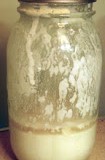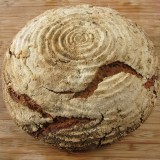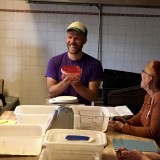
The last survivor, captured with a camera phone before being devoured, because we wanted to eat the pancakes more than we wanted to document them.
This morning I cooked up the best pancakes I’ve ever eaten. They were 100% whole wheat but they were so light and fluffy they tasted like they were made with white flour. And the way they were made is the beginning of a grain revolution. Here’s the secret:
- Use heirloom grains.
- Mill your own flour.
- Ferment for a long time with a sourdough starter.
The heirloom grain I used is Sonora wheat, probably the oldest wheat in the Americas. It’s a soft, winter wheat traditionally used for tortillas.
Recipe (based on Nancy Silverton’s pancakes)
210 grams starter
2 tablespoons maple syrup
3 tablespoons safflower or corn oil
2 eggs
1/2 teaspoon sea salt
1/2 teaspoon baking soda
1 teaspoon baking powder
The night before making these pancakes I take a tablespoon of mature starter and add it to 100 grams of freshly milled Sonora wheat flour and 110 grams of water. This mixture will be the 200 grams of starter you’ll use in the recipe.
The next day mix all the ingredients together, fry them up in a pan and get ready to have your pancake paradigm shifted.
New frontiers in baking
Freshly milled heirloom wheat mixed into a very wet dough and fermented for a long period with a sourdough starter is also the way that Dave Miller, a Chico California based baker, makes his bread. He takes 100% whole wheat dough, every bit as wet and gloppy as pancake batter, deftly shapes it into loaves and bakes the best bread on the west coast. The Los Angeles Bread Bakers, a group I co-founded, is hosting a sold out class with Miller later this month and I hope to share on this blog what I learn. There is increasing evidence that this method of baking results in a much healthier product.




Why use baking soda in this recipe? My understanding is that it needs an acid ingredient to react. http://en.wikipedia.org/wiki/Baking_soda
I believe the starter itself is the acid in this case. That said, I also know folks who don’t use any extra rising agents and just have flat pancakes. That works too.
Indeed–in a sourdough culture, lactobacillus creates the acid.
After ET asked, I also thought the starter was the acid. Fermented foods are safe because the fermentation creates lactic acid.
But if the leavening is coming from the baking soda reacting with the acid in the starter, then you wouldn’t need to feed the starter. You could just put old starter in the pancake mix. Which would mean you wouldn’t have to plan ahead. Which would be awesome.
Anybody care to test this?
You’re right — I guess if you’re using all that extra leavening you could just mix up some freshly ground flour (in an ideal world, that is) and water and go to town. In that case you’re making regular pancakes. I’m sure it would work. I suppose the point of the starter/fermentation stage is the developed flavor, and whatever health/nutrition benefits the fermentation stage would add to the mix.
I’m just to going to reiterate here that those pancakes were deefrickenlicious. We’ve made that recipe many times with starter made with ordinary flour (a good way to deal with excess starter), and it has always been good. But made with the fresh ground Sonora whole wheat flour? Amazing. Tender. Fresh. Fragrant. You could test them on whole wheat haters and they’d never ever guess they were 100% whole wheat.
Ruben–I know a chef that used to make sourdough pancakes in the restaurant he worked in. He did not use any leavening other than the starter itself. It makes a thinner pancake–I’ll give it a try next time.
Awesome, thank you.
Hey Erik,
Thanks for increasing my repertoire of “impressing girls in the morning”
John, you made me laugh out loud. It’s a good thing that I had neither food nor drink in my mouth.
Gah! Please post heavily detailed text and videos on your time with Dave Miller.
I have recently dialled back the hydration of my bread, and ditched the poolish again. My final hydration is now back at 90%, and this gives me a loaf that will hold its shape enough to slash and get some oven spring.
I was hoping the high-hydration, poolish, and handling a la Ponsford would give me a hole-y-er crumb, but it only slightly improved it, and I lost the oven spring.
I may even drop down to 85% and see how it goes. Also, the next step is to try increasing the size of my loaf slightly and see how that works in my pan.
So, any wisdom from Dave Miller would be greatly appreciated.
And thank you for the pancake recipe…
Miller has given LA Bread Bakers permission to film. Hopefully I’ll be able to link to the video.
Two pro-bakers I know just visited Miller’s bakery. They left humbled. He has amazing dexterity and can take 110% hydration dough and deftly shape it into loaves. Until I take the class (and practice!) I’m going to dial back my hydration too–I’ve been having the same problem you are. The secret seems to be in the way the dough is handled, especially the way it is shaped. My whole bread baking method is being turned upside down now!
Great news. I will be curious to see how the crumb of his loaf looks.
Those pancakes sound wonderful but you have taken what is, in my house anyway, a brilliantly quick-and-easy favourite meal and made it require planning. Grinding flour, tending a sourdough starter…I guess we’re sticking with the house mix (and it is a mix: I make a big bin of the dry ingredients once every six weeks or so, lest I have to actually measure before I’ve had coffee) over here. Barley flour, flax meal, organic eggs and my good homemade yogurt. Pancake nirvana.
Your pancakes sound amazing. Don’t change a good thing!
I think you’ve finally convinced me to get a sourdough start going (like it’s so hard) and use it in baking.
Great. One more bowl in the kitchen and/or fridge for my H to harp about. It started with sprouting grains and has moved on from there.
Oh, well. One pancake and he’ll learn to love it!
I really, really want a flour grinder.
Your recipe is identical to the one I use except 300g less starter.
http://www.wildyeastblog.com/2009/02/24/sourdough-pancakes/
With 510g vs your 210 do you find using 2 eggs is too much? Obviously they tasted good so I guess not, I was just surprised that your recipe wasn’t scaled down in other areas besides the starter.
thanks for sharing!
Hey Ed–I’ll have to give your recipe a try. I’ve been using this recipe for years–based on the one in Nancy Silverton’s Bread cookbook. I’ve moved on from her breads–I no longer knead and I don’t like her starter instructions, but the pancake and waffle recipes are pretty good.
Oh, and duh, just noticed your recipe is based on Silverton too. By the way, I’ve landed on your blog before–very cool–keep up the good work.
Woops! Sorry for making it seem like I was linking to my own website. I am not the author of that site, I was only linking to them because that recipe is my go-to and I had noticed to similarity to the one you posted. I am not sure who the author is but it is a favorite site for me as well.
After reading your post I tried your recipe and did the overnight fermentation with some of my sourdough starter. Unfortunately I did not have freshly ground whole wheat so I just used what I had in the cupboard. The batch was a hit with the family.
What I love about the wildyeastblog recipe is that it used 510g of full starter, not need to plan the night before you just need to have a large stock of discard starter. I do not like throwing away starter so when I feed it so I use a 2nd container with the discard and it doesn’t get fed (not much anyway). This throwaway batch is used for the pancakes and sourdough buttermilk biscuits!
When I use the discard starter it has been in the fridge for a while and I find it really gives the pancakes a strong sour flavor which I like. They are also super soft and airy but the downside is that they always come out very thin because the batter is a bit watery. The whole wheat batch I made a few days ago using the overnight mix was thicker and I made thicker pancakes.
Always tinkering…thanks for sharing!
Hey Ed–I’d suggest feeding the starter at room temp for a few days before using that way it will be more active. And glad they were a hit with the family.
In response to Ruben’s comment about using old starter to make pancakes: it works! I’ve been keeping a starter using your recipe for years. Rather than throw away what I have to pour off when I feed it, I keep it in a jar in the fridge. When I have about 2 cups’ worth, I make pancakes by mixing in two eggs or a 1/2 cup applesauce, 1 Tbsp brown sugar, 1 tsp baking soda, 1/2 tsp salt, and about 1/4 to 1/3 cup of something “gritty,” like cornmeal or ground oats (combine dry ingredients separately then stir into wet). The batter foams up a lot initially, which makes the first few pancakes quite lacey and crispy (but the rest are good, too). They turn out best if you spread the batter on the pan to form a thin pancake, more like a crepe than like the fluffy beautiful things pictured above. The one downside of using old starter is that thicker pancakes turn out gummy (though thin ones are light and have a lovely sour flavor, good with apple sauce or goat cheese).
(The same basic idea works for making something like veggie okonomiyaki: pour a thin layer of batter over some sauteed seasoned julienned veggies. Texture is best the next day, for some reason.)
I yearn for a grain mill. Soon’s I have one, your whole wheat pancake recipe will be one of the first that I try. Thanks!